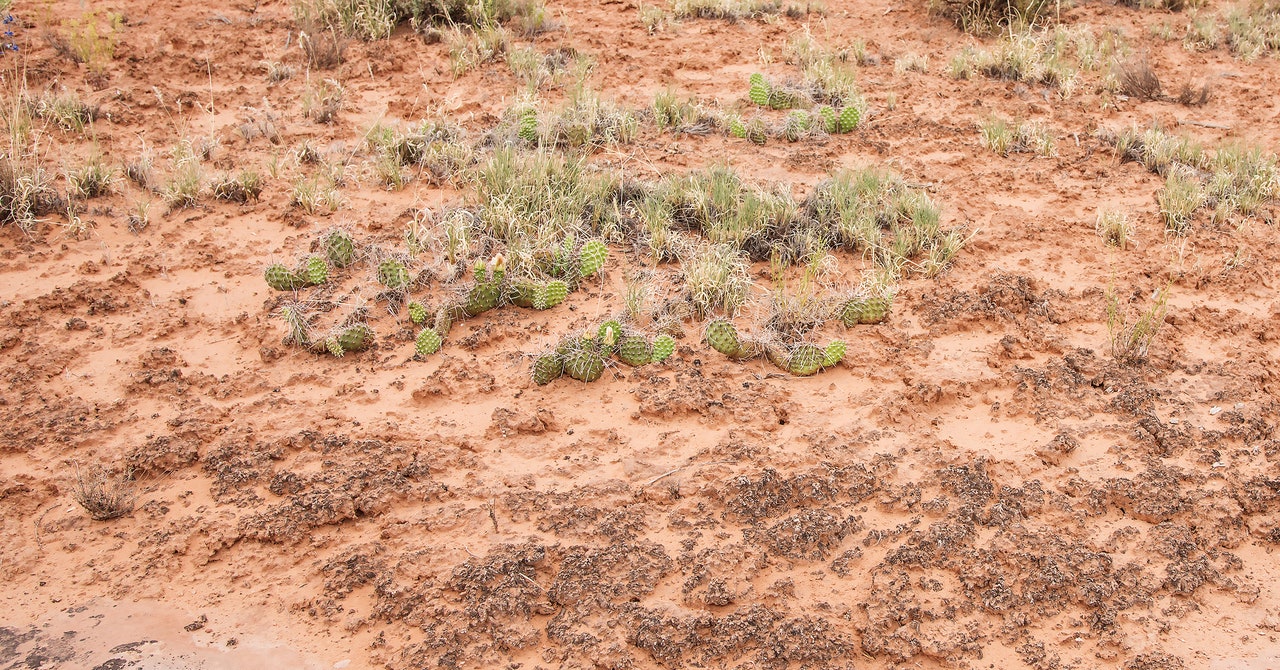
“When you trample it, you’re resetting a clock that’s been going for a long time back to zero,” says Finger-Higgens, whose latest findings on biocrust degradation were published last month in PNAS. “And so now the system has to repair itself.”
To keep her plots devoid of damage, Finger-Higgins prefers to keep quiet about the exact location of her research site. But what should be immaculate desert crust with white fungi peeping through, she says, is not as healthy as expected. Something is amiss—and not just on the Colorado Plateau (which bleeds into four US states: Utah, Colorado, Arizona, and New Mexico), but elsewhere too.
Deserts are, in some ways, the forgotten landscapes of climate change. This is all the more incredible considering drylands cover around 40 percent of Earth’s land surface and support some 2 billion people, with biocrusts covering 12 percent of our planet’s surface. And yet Finger-Higgins’s study suggests that even without human interference, “warming may partially negate decades of protection from disturbance, with biocrust communities reaching a vital tipping point.” A “tipping point” refers to the moment when ecosystems can only take so much more stress before they fundamentally change.
Rising temperatures and drought mean we may be “circling the drain on that,” says Finger-Higgens. Nitrogen-fixing lichens seemingly held steady from 1967 to 1996 at 19 percent of the biocrust’s cover, but then they dropped from this constant down to 5 percent in 2019. “Our study corroborates a lot of experimental work that is done globally. It shows that there are upper heat limits to biocrust that we didn’t fully know until recently.”
Bala Chaudhary, a soil ecologist and assistant professor at Dartmouth College who was not involved in the study, agrees. Even if humans are proactive about how their physical presence affects the landscape, “biocrusts are being impacted by global climate change,” she says.
Of course, it’s tough for even long-term observational studies to whittle away all the possible confounding factors, which is why scientists have also taken experimental steps to simulate biocrusts in a warming world.
For example, between 2005 and 2014 a team used infrared heat lamps to warm a plot of crust on the Colorado Plateau by 2–4 degrees Celsius. They too found that warming led to a decline in mosses and lichen compared to an unaltered plot of land.
Then there was a 2018 study that analyzed data from more than 500 publications and estimated that biocrusts “will decrease by about 25–40 percent within 65 years, due to anthropogenically caused climate change and land-use intensification.”
Finger-Higgens’s “paper offers a little more realism” than these experimental studies, says Bowker. It shows “something that unfolded over an extended period of time in a natural ecosystem.”
So is stripping the desert of its crusty skin really a big deal? If you have spent time in the southwest of the US, you know it’s extremely windy and that storm systems can whip through the land. The biocrust acts as a protective layer—a kind of glue that holds the soil together. Biocrusts are sometimes referred to as ecosystem engineers, says Chaudhary, who compares them to beavers in their ability to alter a landscape.


